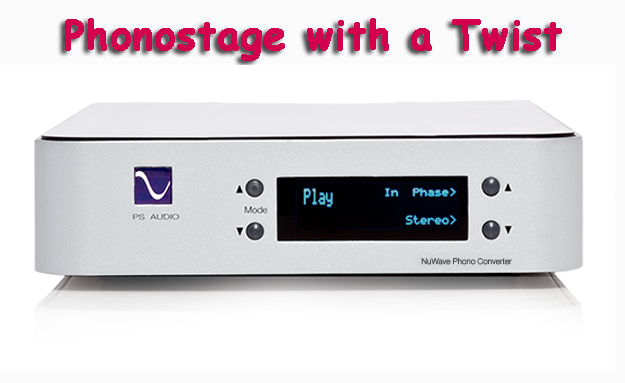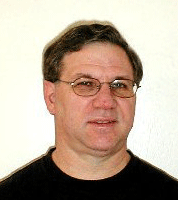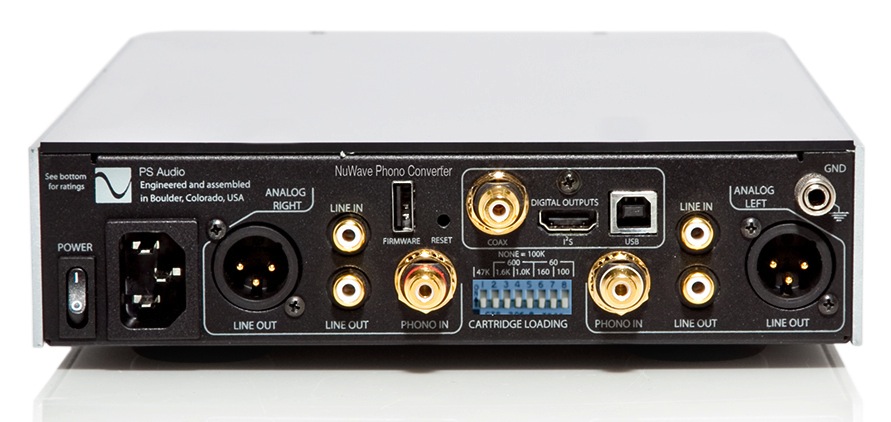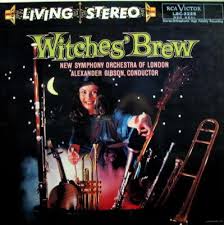PS Audio NuWavePhono Converter


Over the past few years I’ve become a fan of PS Audio’s Paul McGowan and his daily e-mail blogs, i.e. “Paul’s Posts,” where Paul provides short blogs on many audiophile topics including the rationale behind PS Audio’s product development, occasionally sprinkled with some very interesting and amusing anecdotes. I appreciate that he shares his insider viewpoint in his genuine, open, and non-pushy manner.
It was through “Paul’s Posts,” and his monthly newsletter that I learned of PS Audio’s NuWave Phono Converter (NPC) that differs from the usual phono preamp in that it contains a high-performance fully analog phono preamplifier and a separate high-resolution A to D converter on the same chassis.
Well, what good is that, one might ask? Here’s the deal. In truth the NPC is like a sophisticated, high-resolution tool you can use to make your own compact recording studio. In addition to serving as an excellent, full-feature phono preamp in its own right, it can convert the analog output from records and tapes to a digital stream that can be output to a computer via either USB or S/PDIF connectors. The digital stream can thus be recorded on any computer with the requisite recording software. I’ve found that the NPC facilitates making nearly perfect copies of not only phonograph records, but of any type of analog source. And since it runs as a core DSD converter with input sampling at 352,800Hz (5.6MHz) per second, it even has the potential to make Master-quality recordings from a live feed by using quality microphones using and an appropriate microphone preamp. The NPC produces both high resolution DSD or PCM from its digital outputs and superb fully balanced analog from its RCA or Balanced XLR audio outputs.Cool beans, huh!
So while some users will be perfectly content to use the NPC as an excellent, high quality analog phono preamp, others will use it to archive their favorite LP records and tapes. (Stay tuned for more on that later.) And musicians can even make their own recordings and then down sample them to CD, Mp3, or other types of downloadable media files. Just between you and me, for all the NPC can do, its suggested list price of only $1,895 is a steal!
Features
The NuWavePhono Converter has many intuitive and useful features and the latest chic rounded corners that many new components now offer. The rear panel contains one pair of RCA line inputs and a pair of high-quality RCA phono inputs that provide the RIAA equalization. There is also a USB input but it is only purpose is for firmware updates if and when they are available.

Outputs include one pair of RCA analog phono outputs and a pair of Balanced XLR outputs. On the digital side we have a coaxial S/PDIF output, an asynchronous USB output, and an I2S output via HDMI connector. I should mention that the USB output is only intended mainly for connecting to a computer for recording purposes. It will not work to feed the input of a USB DAC. Also, the HDMI output will not work with standard HDMI inputs found on other equipment like Televisions, Blu-ray players or gaming consoles. It is meant for connection to other audio gear like PS Audio’s Perfect Wave DAC that use the I2S configuration via HDMI. This makes for a very high resolution jitter-free connection.
On the front of the NPC is an OLED screen display flanked by two up/down buttons on each side. One side scrolls through seven different modes of operation while the other side selects the different options for each mode. This is a fairly easy and intuitive system to comprehend—much easier than any Blu-ray player or A/V receiver.
I loved the easy cartridge gain settings. There are twenty-one possible gain settings between 18dB and 78dB in 3dB steps displayed via the front panel menu. Fantastic! And of course I scrolled way up to 78dB for my 0.25mV output MC cartridge! Best of all, there was very low noise even with full gain at healthy volume levels… the kind of noise you can only hear with your ear up real close to the speaker drivers (even with the RCA outputs). Nice!
The rear panel contains a 10-switch array for setting the cartridge load. There are quite a few possible combinations of loading options since the resistors can be paralleled in tandem. I believe 8 of the many possible positions are diagramed on the panel around the switch array. I pushed up switches 9 and 10, which results in a load of 100 Ohms for my low-output moving coil cartridge. The manual shows settings for as low as 60 Ohms and as high as 100k Ohms. It is also easy to set for the standard 47k Ohm load that most moving magnet cartridges specify. And since both the cartridge load settings and the gain settings are accessible from outside the box, I give the NPC two thumbs up for ergonomic ease!
Another nice feature that PS Audio likes to include on its phono preamps is a polarity (phase) reversal option at the push of a button. I tried it out with several of my favorite recordings and found that a few of them did indeed sound more natural with the polarity reversed. If your speakers are phase coherent (meaning no crossovers in the critical midrange), you should be able to hear the difference and take advantage of this thoughtful feature. Unlike some phase/polarity switches on other gear I have used, this particular invert function seems to be just as effective as switching the positive and negative speaker leads at the amplifier or speaker.
Other operational procedures and features are explained thoroughly in the manual so I won’t go into that in any detail here. Suffice it to say that I found the NPC itself quite easy to understand and operate. The thing I found a bit more complicated was getting the actual recording software to do what I had in mind, which is in no way a fault of the NPC and had more to do with my unfamiliarity with using the recording software I installed in my computer. But I will say that despite my minor quibbles with the recording software I was able to make some excellent recordings. More on that later…
Set up
The NuWavePhono Converter installs just like most other phono preamps with all the usual connections and adjustments. The interesting thing is that if you have a very good DAC you will have two playback options. One option will be to use the NPC’s analog outputs into your preamp or integrated amp and the other would be to use the S/PDIF or I2S digital outputs into your DAC. My Lyngdorf DPA-1 preamp lacks the I2S interface, but I was able to use the NPC’s S/PDIF digital output and its analog outputs as well. This meant I could compare the NPC’s full analog signal path with its digital output through my S/PDIF cable at the touch of a button on my DPA-1’s remote.
My personal finding using my gear and cabling is that the NPC’s pure analog path sounds slightly more natural than its digital output. However I will admit it was a very close contest and that the results could’ve been reversed if I changed my digital cable or DAC (which is built into my Lyngdorf). So this is one area that individual purchasers will need to sort out for themselves using their own gear.
I installed the PS Audio in my Large-Room Reference system in place of the Manley Chinook phono stage I reviewed several months ago. My amplifier is the Rogue Audio Medusa tube hybrid and my speakers are the Brian Cheney Signature version of the VMPS RM40 ribbon-hybrid line arrays, which have bass extension down to 24 Hz and work very well in my 14’ x 30’ listening room.
On the recommendation of PS Audio, I downloaded and employed AlpineSoft’s Vinyl Studio recording software (http://www.alpinesoft.co.uk). I’m running a dual-core Lenovo T60 laptop computer using the old Windows XP platform. My media player of choice is the free version of the J. River Media Jukebox 14, which sounds great and plays all kinds of music files including very high resolution files.
My main problem with VinylStudio involved splitting the tracks in the right places but that turned out to be my unfamiliarity with the program and I did receive very good support from AlpineSoft.Vinyl Studio has an excellent pop and tick remover that has settable parameters but worked extremely well for me on its default settings. And once I made, split, filtered, and saved the tracks I was mighty impressed with the quality of the recordings this setup was able to produce. I was told that the Vinyl Studio software is easier to operate and understand than other software recording programs. Good thing for me!
PS Audio says that Windows users need to download a driver to their computers to communicate with the NPC, while MAC users will most likely have a compatible driver built in. I downloaded the USB 2.0 driver from the PS Audio website and followed the manual to find the proper sequence for installing and using the driver in VinylStudio.
You can record in either DSD or PCM and different levels of resolution can be selected. PS Audio advises that using 24/96 kHz resolution is more than adequate for any PCM-based LP recording and I completely agree. In fact, I recorded two record albums at the lower 24-Bit/48 kHz resolution to save space on my hard drive and compared to playing the original record I didn’t feel I lost even the slightest bit of detail or dynamics.
Let ‘er rip!
Okay, first of all I should make it clear that the NPC (in my experience) is without question the best phono stage that PS Audio has ever designed and produced. It is considerably quieter than the company’s earlier GCPH unit and can be used with lower output moving coil cartridges without any hum or noise issues cropping up. Indeed, with its maximum of 78 dB of gain and many loading options it should fit into most installations without a hitch.
The NPC is meant to be powered up continuously and I spun a few records and left it powered on for a few weeks before making my critical assessment. The NPC sounds a bit thin through the midrange at first, but then with a bit of break in, it begins to flesh out and sounds smoother and more musical.
One of the first things I noticed was that the NPC had considerable command of the bass range in both articulation and extension. PS Audio has built in a wow/rumble filter that rolls off the lowest bass at 18dB per octave below the ultra low frequency of 5Hz and this works very well. It can keep your woofers from hyper-ventilating and mucking up the sound in the audible frequency range while having no effect on perceivable bass weight, impact, or articulation.
 I was very impressed with the weight, resolution and punch of the NPC on my favorite bass-heavy pop recordings but what really drove the point home for me was playing two of my reference classical pieces, Witches’ Brew (RCA LSC2225), and Igor Stravinsky Conducts – 1961 (Columbia MS 6272).
I was very impressed with the weight, resolution and punch of the NPC on my favorite bass-heavy pop recordings but what really drove the point home for me was playing two of my reference classical pieces, Witches’ Brew (RCA LSC2225), and Igor Stravinsky Conducts – 1961 (Columbia MS 6272).
On Stravinsky’s The Royal March: The little Concerto I got a taste of what the NPC could do in the bass and it was most impressive. It was very evident which types of drums were being struck. Of course the poignant rat-a-tat of the snare was easily recognized but with the tympani you could hear the drum head being struck and the reverb in the basket, not to mention the distinct tonal character of the drum. With the big bass drum I noticed the sound was deeper and the reverb lasted a bit longer. I had not observed this kind of detail previously and it was a welcome surprise.
And on Arnold’s Overture to Tam-O’Shanter, from Witches’ Brew, the kettle drums rollin like a huge thunder storm with gong and cymbal crashes that simulate potent lightning strikes with all the presence and power of large symphony orchestra playing at full tilt. The whips cracking was a nice touch too with the trumpets heralding the ominous storm. By the end of the storm sequence I found myself lounging on the loveseat clicking my heels together and muttering “There’s no place like home, there’s no place like home.”
This recording is powerful, full of emotion and even a bit creepy. It is a fitting tribute to the great poet Robert Burns and the NPC delivered its sheer power and emotion extremely well. But more than that, it demonstrated the importance of a solid bass foundation underpinning the theme of a great musical composition. The NPC perfectly illustrated this concept for me.
Yet the NPC delivers more than great bass articulation and extension. It also excels in its reproduction of vocals. Indeed, Karla Bonoff sang “Rose in the Garden” ever so sweetly on her self-titled album (Columbia 34672) accompanied by a soulful electric guitar she artfully delivered her emotive plea.
 Male vocalists were also well served by the NPC. Johnny Cash’s voice had just the right amount of chesty emphasis singing “Down There by the Train” from his Cash album (American 9-45520-1). And Terence Trent D’Arby’s voice had that trace of texture he is known for when he sang “Wishing Well” (Columbia 44-07542). I should also mention that the synthesizer bass in the intro was distinct and powerful and the female vocal at the end sounded very spirited and clean… not screechy as it sometimes can be with lesser quality phono setups.
Male vocalists were also well served by the NPC. Johnny Cash’s voice had just the right amount of chesty emphasis singing “Down There by the Train” from his Cash album (American 9-45520-1). And Terence Trent D’Arby’s voice had that trace of texture he is known for when he sang “Wishing Well” (Columbia 44-07542). I should also mention that the synthesizer bass in the intro was distinct and powerful and the female vocal at the end sounded very spirited and clean… not screechy as it sometimes can be with lesser quality phono setups.
In the soundstaging department the NPC scores top honors producing very wide, deep and layered imagery. This was especially apparent with classical symphonic music where the orchestra spread wall to wall and had a good sense of depth and instrumental placement. Violins were usually on the left, brass on the right, tympani and bass drum in the rear (sometimes right or left of rear stage depending on the recording), etc. And individual instruments could be picked out of the mix in exact locations dictated by the recording.
I have no major quibbles with the sound of the NPCphono stage. The bass reproduction is among the best I’ve heard if not “the best,” the imaging was expansive and vivid, and vocalists were very well served. If I have a criticism it is perhaps that the PS Audio NPC is too neutral, meaning, I suppose, that it gives you what is on the record, nothing more and nothing less. It does not get overly flowery or embellish the way some tube units do.
Compared to my Manley Chinook, it has more extended bass, but beyond that, it sounds a little more matter-of-fact in the midrange and highs, where the Manley has slightly more bloom. I’m thinking that this is the basic and innate difference between a very high quality tube preamp versus a very high quality solid-state design (having heard several of each type).
About recording
As I mentioned earlier I had some newbie issues with using the VinylStudio recording software, mainly in splitting the tracks in the right places. Despite that, I was able to make some truly excellent sounding high-resolution digital recordings using the NPC to convert the analog signal to a digital stream, which was then stored as music files in the format of my choice on my computer. Later I was able to convert my AIFF files to WAV files and burn them to CD’s, or just simply put them on a flash drive in full high resolution AIFF for playback on any USB-equipped computer with a compatible media player.
I liked that I could then access the music files as individual tracks and elect to play them in any order. I also liked that I could remove the ticks and pops from the recorded files without affecting their perceived sound quality. I have AlpineSoft’s VinylStudio program to thank for that.
At the time of this writing, I have recorded 3 complete LP albums using the NPC. They are the Talking Heads’ Stop Making Sense, Ry Cooder’s Bop Till You Drop, and Witches’ Brew. I recorded Witches’ Brew at 24/96 and the two others at 24/48 and found that to provide very convincing results. What was curious to me is that if anything, the copies seemed a bit more musical than the original records… a little more like the Manley Chinook’s slightly more forward midrange/treble presentation… but with a bit more bass slam. And with the pops and ticks cleaned up, well, that is the icing on the cake! I also found myself playing the copies back at higher volume levels than I normally set for playing the records—and that I seemed to be tapping my toes a bit more followed by my dancing (if one could call it that) around the room. I had my fun!
Summary
When I first received the PS Audio NuWave Phono Converter I was thinking that it would have a well-performing phono section and a recording feature I would have little use for. As it turns out, I was half right—the phono stage sounds quite impressive as I outlined above, but I really got into the recording side of it much more than I ever thought I would. Once I listened and heard how great the recordings turned out and that I could remove the ticks and pops, separate the tracks, and use the files on any computer or to make high-quality CD’s, I was like a kid who just found a great new toy. And I intend to party on—and twist again, like I did last summer!


frank alles
Manufacturer
PS Audio
4826 Sterling Drive
Boulder, CO 80301
Phone: 1720.406.8946
Web: www.psaudio.com
Description
PS Audio NuWavePhono Converter
Dimensions: 7.5”W x 14”D x 3.5”H
Shipping Weight: 14 lbs.
Price: $1,895 USD
Please visit:http://www.psaudio.com/shop/nuwave-phono-converter/ for more information on specs and features.
Stereo Times Masthead
Publisher/Founder
Clement Perry
Editor
Dave Thomas
Senior Editors
Frank Alles, Mike Girardi, Key Kim, Russell Lichter, Terry London, Moreno Mitchell, Paul Szabady, Bill Wells, Mike Wright, Stephen Yan, and Rob Dockery
Current Contributors
David Abramson, Tim Barrall, Dave Allison, Ron Cook, Lewis Dardick, Dan Secula, Don Shaulis, Greg Simmons, Eric Teh, Greg Voth, Richard Willie, Ed Van Winkle, and Rob Dockery
Music Reviewers:
Carlos Sanchez, John Jonczyk, John Sprung and Russell Lichter
Site Management Clement Perry
Ad Designer: Martin Perry





Be the first to comment on: PS Audio NuWavePhono Converter